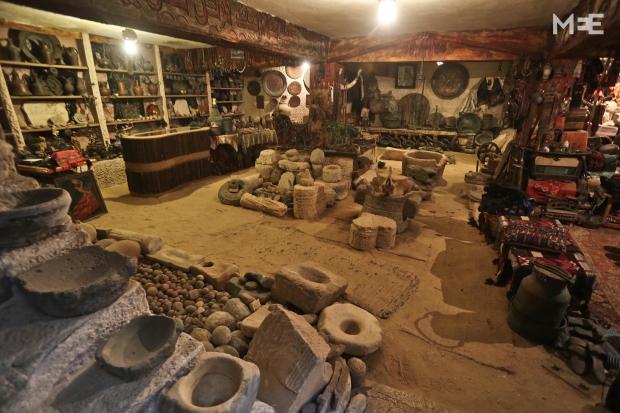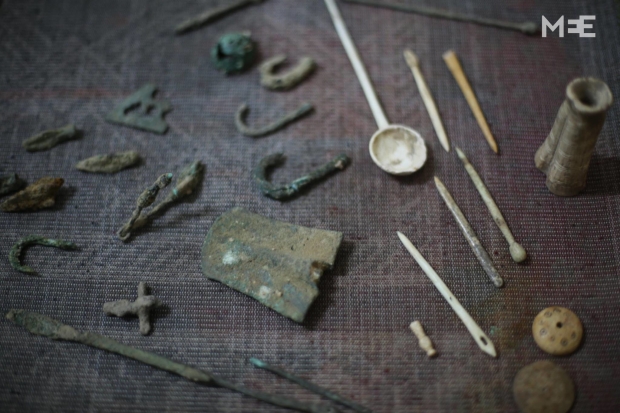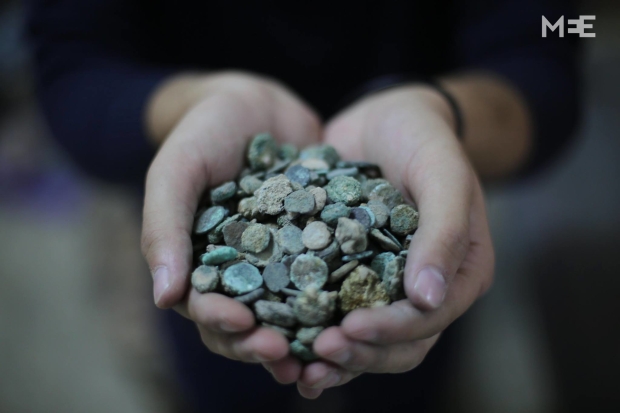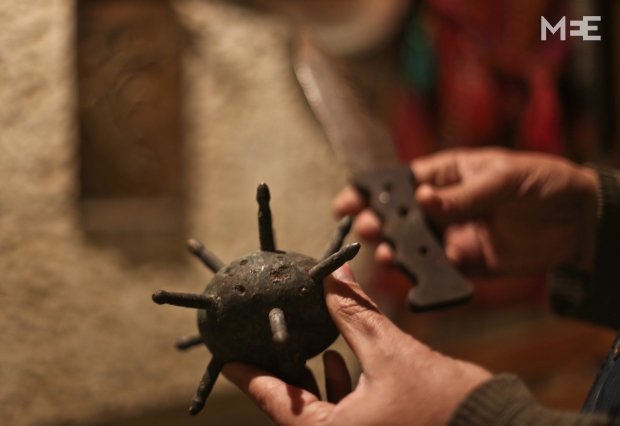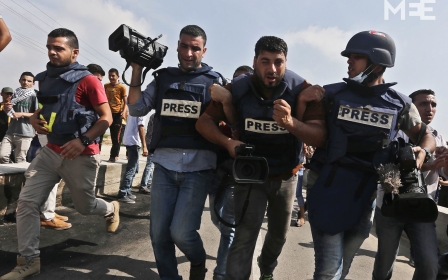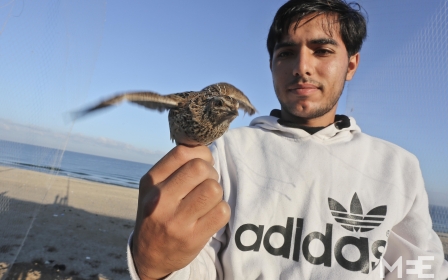Aladdin's cave of wonders helps preserve Gaza's artefacts

GAZA CITY - Just a few hundred metres away from the old Crusader castle, Barquq, named after the Mamluk sultan who died in 1399, is a magnificent staircase leading down to a cellar beneath the home of Merwan Shewan.
Descending the staircase feels like being transported back in time through the millennia. At the bottom of the staircase, a rich array of hundreds of historical items and artefacts are crammed together side by side while a yellow ceiling light casts its gentle aura and shadows.
There is much to see and touch: helmets and swords from the early Islamic era; carved stones and metal coins from the Byzantine and Roman eras; a relic from a railway station engraved with the signature of Sultan Abdulhamid II of the Ottoman Empire; and then there are also the more modern objects such as early radios, pots and drinking vessels made of iron and copper.
Gently dusting off one of his cherished items with a soft cloth, Shewan, whose home rests atop this Aladdin's cave of wonders, looks up saying: “You must treat these relics as gently as you would your baby.”
Shewan, a 47-year-old architectural carpenter and designer by profession, loves to explore archaeological dig sites in his free time. To him these strange, beautiful and practical objects that emit the rich fragrance of ages past, all require preservation. Quite often he, and other keen treasure hunters, stumble across ancient artefacts from multicultural legacies of people from all over the world that travelled or settled in Palestine, and he feels they need to be carefully respected as regional treasures.
“I know that I am not an expert, and know no-one who has the expertise to date these items I have collected and cared for,” admits Shewan. But this aspect of the puzzle does not get in his way, for Shewan has been collecting and preserving such items for nearly half a century as his father did before him. Whatever is found of Palestine’s rich and colourful history remains of great interest and excitement to him.
Though he is aware that not all of his collected items may be of great historical or monetary value, he understands that items from the Roman Era could be of significant historical value as they often date back thousands of years.
The exact details of the age and provenance of his artefacts have not yet been confirmed, but Shewan says by looking at the discovered artefacts, he can estimate which era they came from and hopefully be able to save some of the more special pieces.
In the meantime, Shewan collects all that he can, even amid the challenges that the war-torn chaos of Gaza presents, where the ground is ripped apart by Israeli military hardware, and safety for people - let alone artefacts long buried under the ground - is fragile.
“In the late 80s I became more interested in collecting artefacts for preservation, after Israeli military generals offered Palestinians high prices to sell discovered artefacts,” he says as he gently holds what he believes to be ancient stone-encrusted coins of some sort.
“I found them in this small pot,” he says while gently cupping the stones into his hands. “They are irregular in size and shape.”
Some of the first metal coins are said to have come from the Lydian kingdom in western Asia Minor and were made of electrum, an alloy of silver and gold. Merchants in their everyday transactions used these coins. But coins that were made of alloy and stone in Palestine could date back to the Canaan, Roman, Byzantine, early Islamic era, or Ottoman periods.
However, the only verification that Shewan can attest to is that some of the coins have the head of a Roman Emperor with his name written in Latin or Greek on one side, and on the other are different images believed to represent the different imperial regions.
“I wish our present lives were as simple as these coins and as rich as their history,” he says as he smiles and shows a photograph of China’s information minister who paid a visit to his makeshift museum.
Shewan has certain beliefs that he can’t let go of. Most are not scientifically verified or historically proven, but when he holds a tiny pot and speaks of the legend of a queen who used to collect her tears in it, his beliefs are almost contagious. However, as long as Gaza remains under the Israeli and Egyptian blockade, it will be difficult for global experts to come to his cellar to examine, date and record the facts about his stockpile from yesteryear.
In the absence of state-run museums, small privately owned collections of antiquities have become more common in Gaza, as increasing numbers of artefacts are unearthed or exposed by war and turmoil on the ancient grounds of Palestine.
There are two well-known places in Gaza serving as small museums: Al-Basha Palace and Al-Mathaf, which is essentially a showroom belonging to the Mathaf Hotel in Gaza City. They display some ancient documents, artefacts and relics, and say they aim "to preserve the regions' rich history, provide a venue for modern cultural dialogue, and carry a message for this generation to build a brighter future".
Al-Mathaf boasts free admission to anyone wanting to peek into the past. Though it is in a long, narrow stone room to the right of the hotel’s reception desk, one need not be a guest. Artefacts on display range from the Bronze Age or 3500 BC, to the Islamic, Crusader, Roman and Byzantine periods. Many different items including jars, glass items, coins and columns are carefully presented in an ambience that allows for reflection.
The owner is native Gazan Jawad Khoudary of Mathaf. Khoudary recognises and appreciates Shawan's soft spot for old coins and is aware of Gaza coins dating back to the first century, and insists that Gaza once acted as an intersection of several currencies and culture via the seaport.
“In the past we had our own seaport connecting us to the world, where we could connect to Cyprus, Alexandria and China,” he said.
Khoudary has loaned out around 800 artefacts to museum’s in six locations around the world and speaks warmly about Gaza being a place that used to be at the heart of the region's historic civilisations.
“Once we were a civilised city, as we had our own Gaza coins in the fifth century BC like any other Mediterranean city, it was with the Gazan logo,” he says.
Al-Basha Palace dates back to the Mameluke age and is a valuable place historically due to the fact that it was used as the official site for the governor of Gaza during the Ottoman Empire. Its rooms and the cells of the adjoining prison remain the same today as it was back when the Turkish empire presided over the region. Now it is administrated by the Gaza de facto authority, which runs all affairs.
“I can’t allow anything to leave. This is the history of Palestine that should be passed on to our future generations,” he adds, as he carefully picks up what is believed to be a historical copy of the Holy Quran, laying not far away from Palestinian traditional costumes from the 1950s that are based on even older designs.
The lack of state-sponsored museums has prompted more independent Gazans to become collectors of artefacts, yet the public doesn’t see them as valuable, often viewing them as un-needed “junk”. But there are many globally recognised artefacts including a rare bronze statue of the Greek god Apollo that was found in Gaza in 2014.
Not all of the collectors are seasoned historians either. Nineteen-year-old Bara al-Susi from Gaza City developed an interest in collecting anything he thinks is old and valuable. He has collected over 4,000 items from various eras. These include old fishing equipment, domestic spoons, needles, metal and bronze pans, as well as what he identifies as documents he cannot decipher but thinks may be from the Canaan and Pharaonic eras. In addition to these pieces from the past, there are more modern postage stamps from several Arab states, Russia and Germany.
Al-Susi says that he enjoys collecting artefacts while his studies in business administration continue at a local university in Gaza.
Artefacts and heritage sites at risk
For the Palestinian Ministry of Tourism in Gaza, local collectors are not seen as a threat to the artefacts or Palestine’s history, says the deputy head of the ministry Dr Jamal Abu-Reda.
“We are aware of those people collecting them and we thank them for taking care of valuable artefacts during the most difficult years,” he told MEE.
He also understands that preserving artefacts found in Gaza, by private owners, is perhaps the safest solution given the unstable situation, which includes the possibility of the eruption of more war at any given moment.
Gaza has a good share of artefacts that need international heritage protection as they are at risk due to a lack of funds and the dire limitations placed on its cultural heritage from the Israeli siege. In fact, archaeologists are well-aware that the Byzantine Umm Amer site in the middle of Gaza could be the oldest monastery in the Middle East, and say the World Heritage Foundation should officially protect it.
Marc-André Haldimann, a researcher at the University of Bern in Switzerland and an expert on Mediterranean archaeology told the New York Times in 2014 that Gaza had 17 major archaeological sites that were unknown to the outside world.
Coins washed up on Gaza beach
Sometimes he goes out walking and searching for items in archaeological sites such as Nuseirat, Hashem Ben Manaf Palace and the al-Sudania area, west of Gaza City. Though he has little knowledge or proof of where to find metal and bronze coins, Susi does his best by doing research on websites that focus on ancient history and then tries to compare and look for similarities in his findings.
“Byzantine, Greek and Roman coins are among the most common that I have collected. Many still have clear ancient images on them for identification on specialised websites where I can compare photographs and details - some coins need delicate cleaning with chemicals in order to take away the rust, but not ruin the images, writing, metal or stone,” he says.
He is disappointed with the lack of expert patronage from any groups for Palestinian artefacts, however, he hopes one day, to find funding to show his collection to the public in Gaza.
“I hope one day to establish a museum to explore all my artefacts,” he adds.
Susi hopes that, in the meantime, Gaza’s Al-Basha Palace will be the place to store these items and display them to the public.
Shewan understands and respects his national heritage and wants to preserve it for the future. But he fears that in the minds of squabbling political leaders this vision of national identity and heritage will never be a priority.
This article is available in French on Middle East Eye French edition.
Middle East Eye propose une couverture et une analyse indépendantes et incomparables du Moyen-Orient, de l’Afrique du Nord et d’autres régions du monde. Pour en savoir plus sur la reprise de ce contenu et les frais qui s’appliquent, veuillez remplir ce formulaire [en anglais]. Pour en savoir plus sur MEE, cliquez ici [en anglais].


